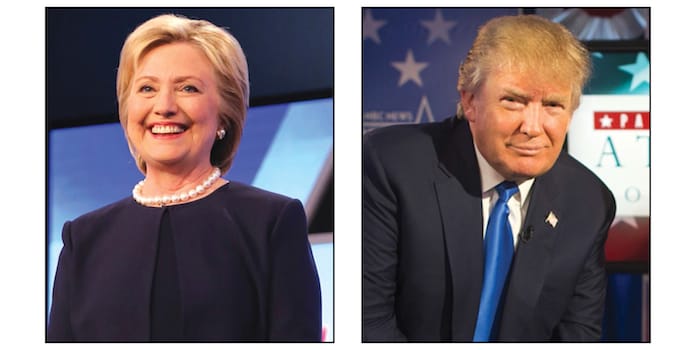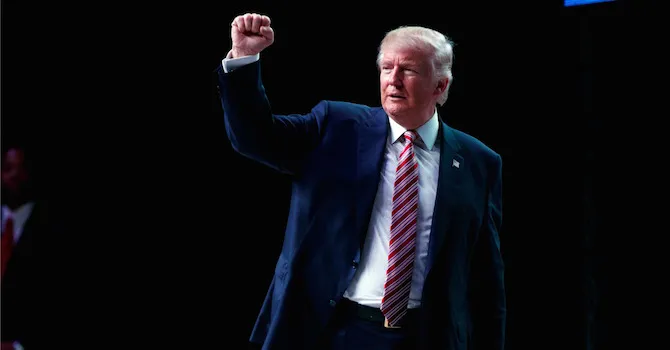
The 2016 presidential election frontrunners: Hillary Clinton (D.) and Donald Trump (R.)
NEW YORK — With the 2016 presidential election drawing near, health care has emerged as a policy area in which the two major candidates’ differences are strikingly clear.
A useful starting point might be their respective approaches to prescription drug pricing. The Republican candidate, Donald Trump, created a sensation in January when he advocated allowing Medicare to negotiate prescription drug prices directly with manufacturers — a move touted by Democrats for years and steadfastly opposed by Republicans. Both Hillary Clinton, the Democratic standard bearer, and her Democratic rival Bernie Sanders had made the policy part of their respective health care plans.
“We don’t do it,” Trump told a crowd in Farmington, N.H. “Why? Because of the drug companies.”
In addition to violating Republican orthodoxy, Trump astonished many by claiming the move could save $300 billion a year. The Committee for a Responsible Federal Budget pointed out that such a figure was impossible since it is more than government pays for drugs annually (according to the Centers for Medicare and Medicaid Services, prescription drug spending reached $297.7 billion in 2014).
The committee’s analysis also noted that the Congressional Budget Office had judged in a 2007 report that giving the Secretary of Health and Human Services authority to negotiate drug prices on behalf of Medicare would yield insignificant savings because the secretary has little negotiating leverage.
The nonpartisan Center for Economic and Policy Research, on the other hand, has estimated that negotiating drug prices directly would save Medicare between $230 billion and $541 billion — but over 10 years.
For her part, Clinton has clearly targeted drug makers in her approach to lowering the cost of prescription drugs, pointing to a 12.2% increase in spending in 2014, up dramatically from 2013’s 2.5% rise. The Democratic candidate has laid out a comparatively more detailed outline of her drug pricing policies than her Republican opponent.

Noting that most other advanced countries ban or severely restrict direct-to-consumer ads by drug manufacturers, Clinton has vowed to end direct-to-consumer ad subsidies and establish a mandatory pre-clearance procedure through the Food and Drug Administration that would ensure such ads provide clear and understandable information to consumers.
In addition, pharma manufacturers who benefit from federal support would be required to invest a certain amount of their revenue in research and development. The Democratic candidate has promised to convene business leaders, drug pricing experts and consumer advocates to help create new parameters for federal support.
Following the precedent of states such as California and Maine, Clinton’s plan would also require health insurance plans to place a monthly limit of $250 on covered out-of-pocket prescription drug costs for individuals. The cap would apply to scripts covered by insurance and specifically approved by the FDA for the treated condition.
In order to boost competition in the industry, Clinton intends to fully fund the FDA’s Office of Generic Drugs to enable the agency to eliminate its multiyear backlog of approvals of pending generic releases. Moreover, she would lower the period of patent exclusivity for biologics from 12 to seven years, thus enabling generic versions of these drugs to appear more quickly.
Additionally, Clinton says she will prohibit “pay for delay” agreements between branded and generic manufacturers that presently keep generics off the market.
Another point on which the candidates agree, at least superficially, is in giving Americans access to less-expensive imported drugs that meet safety standards. “Congress will need the courage to step away from the special interests and do what is right for America,” states Trump’s health plan. “Allowing consumers access to imported, safe and dependable drugs from overseas will bring more options to consumers.”
Another obvious point of comparison between the two is their stance on the Affordable Care Act. Trump has denounced the ACA and promised to call for its total repeal by Congress “on day one” of his administration. By contrast, Clinton has promised not only to defend the ACA, but to improve, strengthen and extend it with the goal of ultimately providing universal affordable health coverage.
However, there is considerable uncertainty about the implications of a repeal of the ACA under a Trump presidency. While Trump has promised in speeches to “take care of everybody,” the health care plan outlined on his website mentions no expansion of coverage nor maintaining protection for people with pre-existing conditions, another point he has frequently addressed in speeches.
Consequently, analyses by nonpartisan organizations estimate that 18 million to 22 million people might lose their coverage under the Trump plan.
The Trump health plan, though, would end the current ban on selling health insurance policies across state lines, as long as the insurer complies with state requirements. By thus freeing up competition, the plan asserts, insurance costs will go down and consumers will have more choice of coverage.
The two candidates clearly differ on their approaches to Medicaid. Clinton has vowed to expand the program in every state. Trump’s policy calls for making block grants to the states and allowing them to administer the programs with less federal oversight.
Clinton, meanwhile, has explicitly promised to expand access to affordable health care regardless of immigration status — in direct contrast to Trump, who claims that simply enforcing current immigration laws would lower the costs of providing health care to illegal immigrants, which he says cost the government $11 billion annually.
Trump also advocates making health insurance premiums fully tax deductible for individuals. Clinton, on the other hand, wants to provide a new, refundable tax credit of up to $5,000 per family for out-of-pocket health care costs that exceed 5% of the family income, provided members are not eligible for Medicare or are claiming other medical deductions.
According to the formal Clinton health care reform plan, “This tax cut will be fully paid for by demanding rebates from drug manufacturers and asking the most fortunate to pay their fair share.”
The Republican candidate would also allow individuals to use Health Savings Accounts (HSAs), making their contributions tax-free and permitting them to accumulate. An HSA account could become part of an individual’s estate and be passed on to heirs without being subject to an estate tax.
Other key tenets of the Clinton health plan include lowering the eligibility age for Medicare to 55 and offering a “public option” that would allow individuals to purchase a government health plan similar to Medicare that would compete with private insurance plans.
Clinton has also adopted a proposal originally put forward by Sanders to expand funding under the ACA for primary care services at community health centers by $40 billion over 10 years while lowering the enrollment eligibility age to 55. She also supports the president’s call to increase funding of the National Health Service Corps to $810 million in 2017 and eventually to $1.3 billion by 2027, which would nearly triple the size of the corps.







